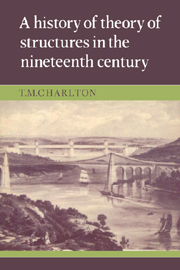Book contents
- Frontmatter
- Contents
- Preface
- 1 Introduction
- 2 Beam systems
- 3 Theory of the arch and suspension bridge
- 4 Elementary theory of frameworks: graphical statics
- 5 Theory of statically-indeterminate frameworks: the reciprocal theorem
- 6 Levy's theory of frameworks and bridge girders
- 7 Early developments of energy principles relating to theory of structures
- 8 The later development and use of energy principles
- 9 Applications of the least work principle: elastic theory of suspension bridges
- 10 Aspects of the further development of theory of structures
- 11 Secondary effects in structures
- Appendices
- Bibliography
- Name index
- Subject index
9 - Applications of the least work principle: elastic theory of suspension bridges
Published online by Cambridge University Press: 18 September 2009
- Frontmatter
- Contents
- Preface
- 1 Introduction
- 2 Beam systems
- 3 Theory of the arch and suspension bridge
- 4 Elementary theory of frameworks: graphical statics
- 5 Theory of statically-indeterminate frameworks: the reciprocal theorem
- 6 Levy's theory of frameworks and bridge girders
- 7 Early developments of energy principles relating to theory of structures
- 8 The later development and use of energy principles
- 9 Applications of the least work principle: elastic theory of suspension bridges
- 10 Aspects of the further development of theory of structures
- 11 Secondary effects in structures
- Appendices
- Bibliography
- Name index
- Subject index
Summary
This chapter deals with the elegant and especially significant applications of the least work principle described by Fränkel (1882). These applications almost certainly originate from his friendship and collaboration with Winkler. Thus, he begins with the relatively difficult problems of the elastic arch and suspension bridge. In so doing, it seems that he was mindful of Winkler's principle (Chapter 3) for the thrust-line of an arch (1879a). Indeed, that principle probably led to his search for a means of establishing a principle of least work for elastic structures generally, the successful outcome of which was marred by the discovery, just as his work was poised for publication, that he had been anticipated by Castigliano. Thus he acknowledges Winkler for that information and it may be judged by the fact that Winkler himself had then only recently become aware of Castigliano's work through the French (1880) edition of the original work.
It will be noted that, throughout application of the least work principle to an arch, Fränkel contrasted the results with those derived by Winkler. Having thus discussed the principle in relation to what he termed ‘the elegant work’ of Winkler, he turned his attention to what he identified as the closely related problem of the stiffened suspension bridge (incorporating inversion of the arch) and succeeded in determining the elastic theory in advance of Levy's celebrated treatment (Chapter 3).
- Type
- Chapter
- Information
- A History of the Theory of Structures in the Nineteenth Century , pp. 132 - 139Publisher: Cambridge University PressPrint publication year: 1982

